Abstract
Aspartic acid in the second transmembrane domain is a highly conserved amino acid among the G protein-coupled receptors and is functionally important for agonist binding and G-protein coupling in beta 2-adrenergic and luteinizing hormone receptors. To determine whether this aspartic acid is also involved in the function of the rat vascular angiotensin II receptor subtype 1 (AT1a), Asp74 was replaced either by asparagine or by glutamic acid. When expressed in CHO cells, the two mutants and the wild-type receptor displayed similarly high affinities for the agonist [Sar1, Tyr(125I)4]angiotensin II [where Sar is sarcosine and Tyr(125I) is monoiodinated tyrosine] and the other agonists: ([Sar1]angiotensin II > angiotensin II > angiotensin III >> angiotensin I). However, the Asn74 mutant shows striking differences in its affinity for some antagonists when compared with the wild-type receptor: the affinity for DUP753 was decreased 10-fold, whereas it was increased 6-fold for [Sar1,Ala8]angiotensin II and 20-fold for CGP42112A. These pharmacological changes were associated with a major defect in transmembrane signaling, since angiotensin II was unable to stimulate inositol phosphate production and increase cytosolic Ca2+ concentration through the two mutated receptors, whereas a clear dose-dependent stimulation was observed in cells expressing the wild-type receptor. Angiotensin II was able to promote DNA synthesis through the wild type but not through the mutated receptors. These data indicate that the conserved Asp74 residue of the AT1a receptor is important for the binding of angiotensin II antagonists and is essential for the transmembrane signaling cascade.
Full text
PDF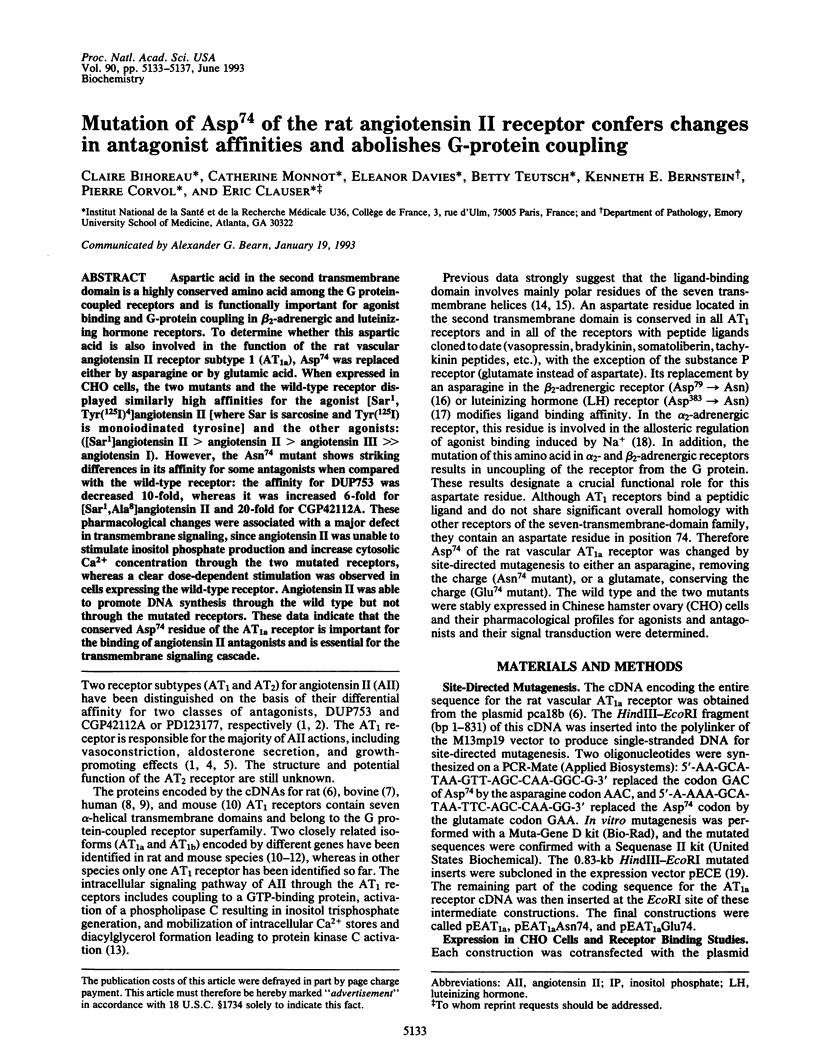
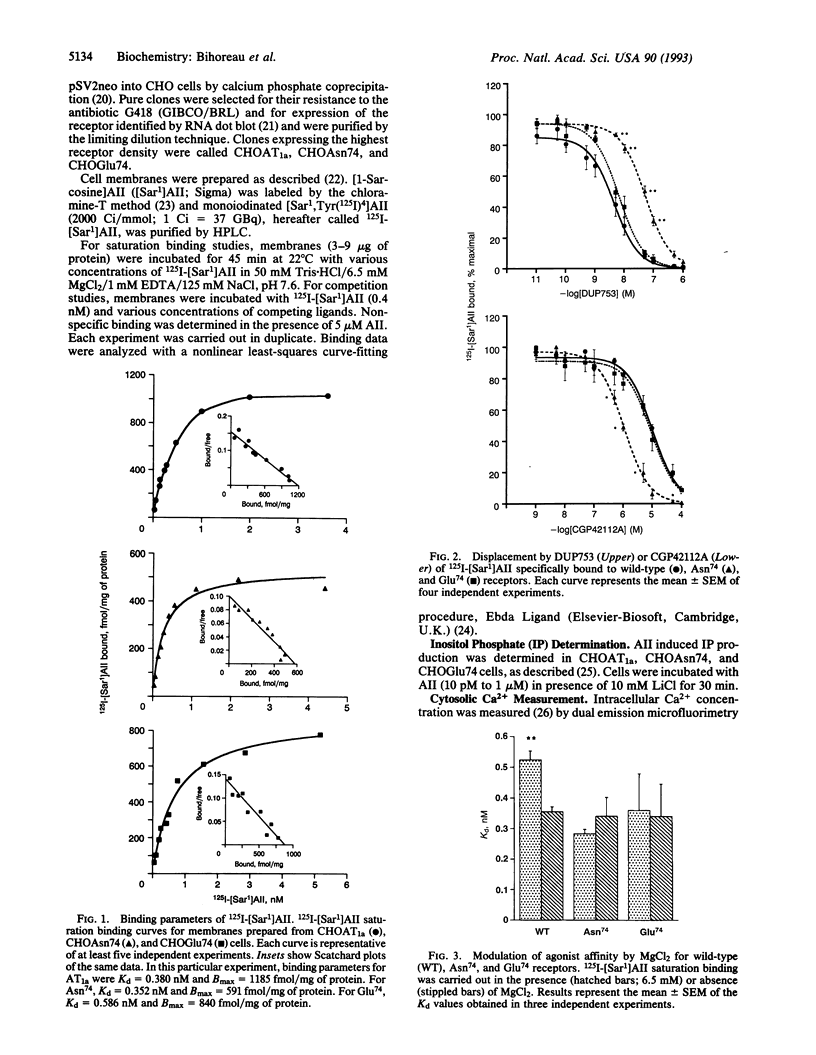
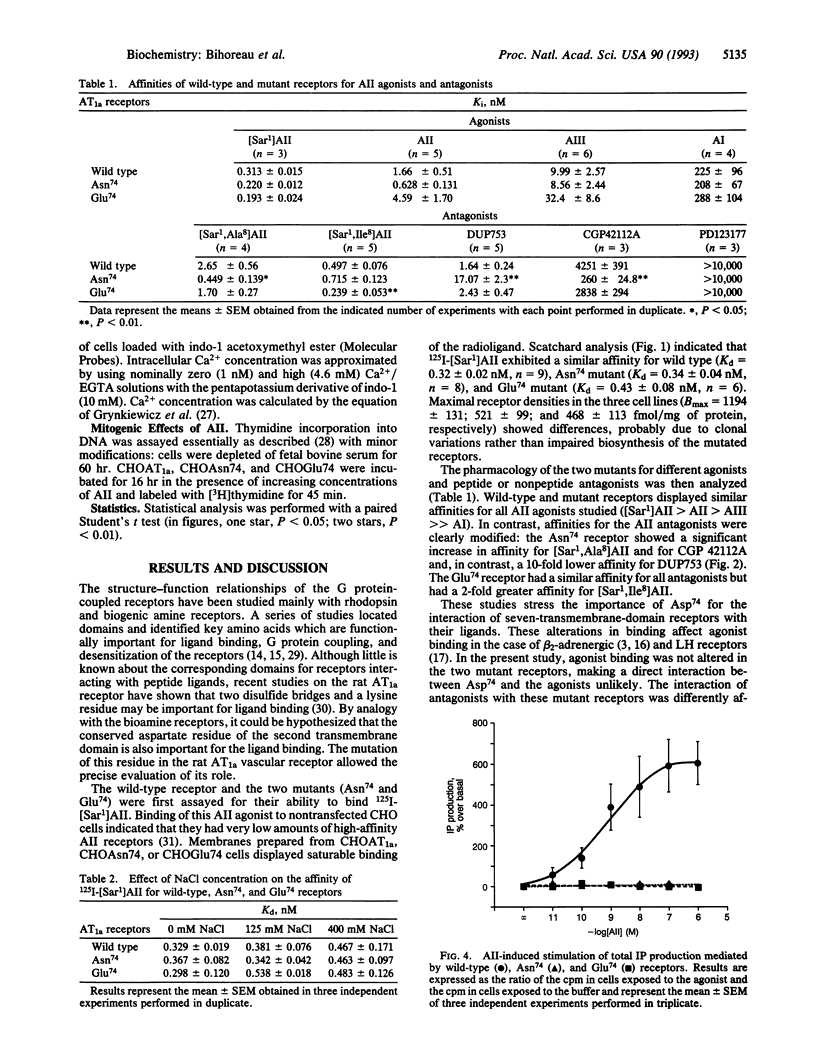
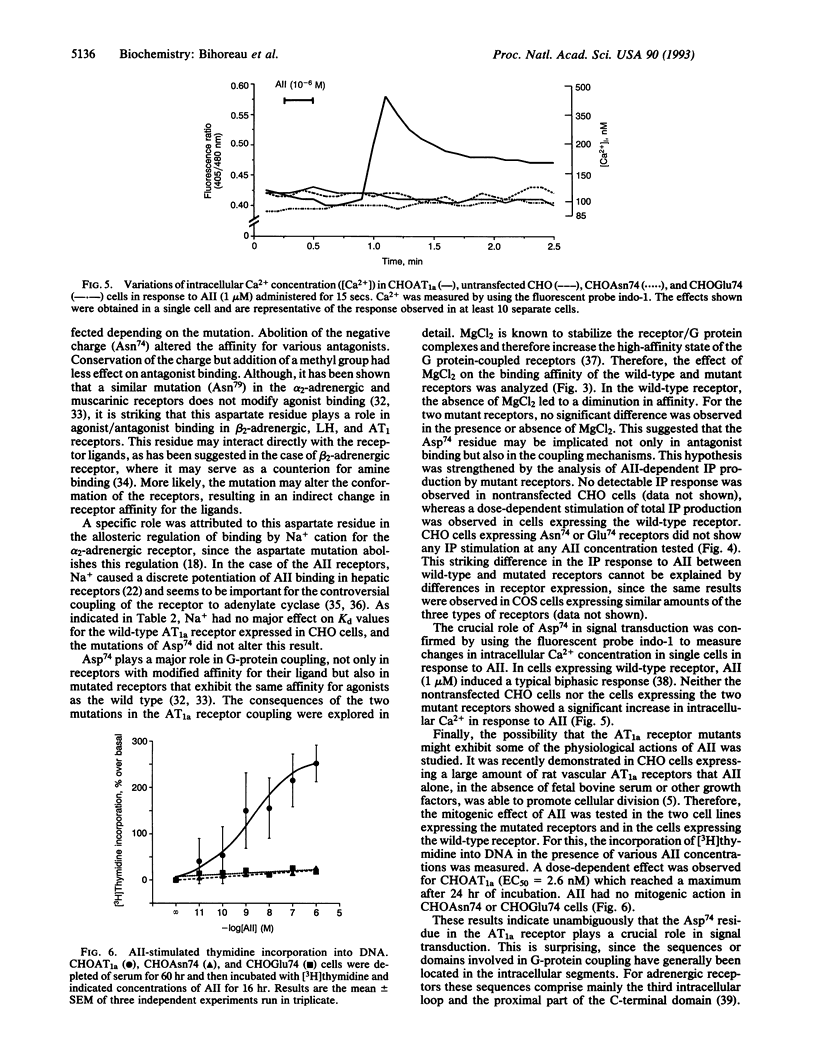
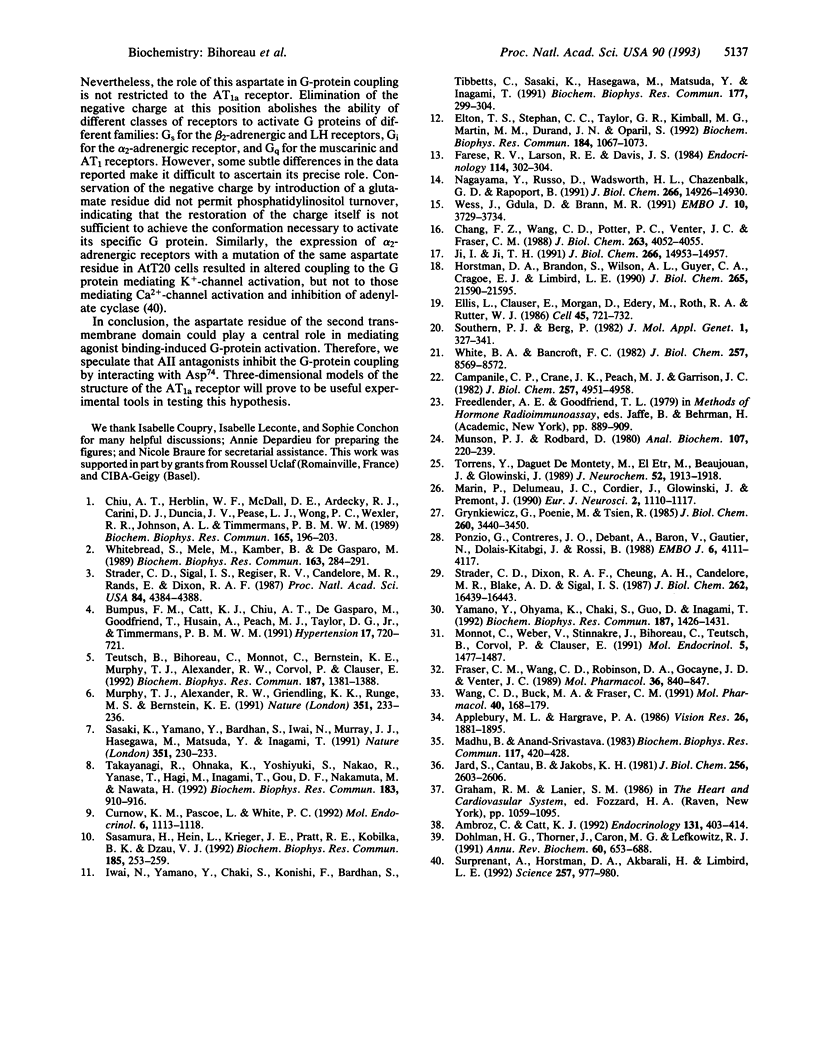
Selected References
These references are in PubMed. This may not be the complete list of references from this article.
- Ambroz C., Catt K. J. Angiotensin II receptor-mediated calcium influx in bovine adrenal glomerulosa cells. Endocrinology. 1992 Jul;131(1):408–414. doi: 10.1210/endo.131.1.1377126. [DOI] [PubMed] [Google Scholar]
- Anand-Srivastava M. B. Angiotensin II receptors negatively coupled to adenylate cyclase in rat aorta. Biochem Biophys Res Commun. 1983 Dec 16;117(2):420–428. doi: 10.1016/0006-291x(83)91217-2. [DOI] [PubMed] [Google Scholar]
- Applebury M. L., Hargrave P. A. Molecular biology of the visual pigments. Vision Res. 1986;26(12):1881–1895. doi: 10.1016/0042-6989(86)90115-x. [DOI] [PubMed] [Google Scholar]
- Bumpus F. M., Catt K. J., Chiu A. T., DeGasparo M., Goodfriend T., Husain A., Peach M. J., Taylor D. G., Jr, Timmermans P. B. Nomenclature for angiotensin receptors. A report of the Nomenclature Committee of the Council for High Blood Pressure Research. Hypertension. 1991 May;17(5):720–721. doi: 10.1161/01.hyp.17.5.720. [DOI] [PubMed] [Google Scholar]
- Campanile C. P., Crane J. K., Peach M. J., Garrison J. C. The hepatic angiotensin II receptor. I. Characterization of the membrane-binding site and correlation with physiological response in hepatocytes. J Biol Chem. 1982 May 10;257(9):4951–4958. [PubMed] [Google Scholar]
- Chiu A. T., Herblin W. F., McCall D. E., Ardecky R. J., Carini D. J., Duncia J. V., Pease L. J., Wong P. C., Wexler R. R., Johnson A. L. Identification of angiotensin II receptor subtypes. Biochem Biophys Res Commun. 1989 Nov 30;165(1):196–203. doi: 10.1016/0006-291x(89)91054-1. [DOI] [PubMed] [Google Scholar]
- Chung F. Z., Wang C. D., Potter P. C., Venter J. C., Fraser C. M. Site-directed mutagenesis and continuous expression of human beta-adrenergic receptors. Identification of a conserved aspartate residue involved in agonist binding and receptor activation. J Biol Chem. 1988 Mar 25;263(9):4052–4055. [PubMed] [Google Scholar]
- Curnow K. M., Pascoe L., White P. C. Genetic analysis of the human type-1 angiotensin II receptor. Mol Endocrinol. 1992 Jul;6(7):1113–1118. doi: 10.1210/mend.6.7.1508224. [DOI] [PubMed] [Google Scholar]
- Dohlman H. G., Thorner J., Caron M. G., Lefkowitz R. J. Model systems for the study of seven-transmembrane-segment receptors. Annu Rev Biochem. 1991;60:653–688. doi: 10.1146/annurev.bi.60.070191.003253. [DOI] [PubMed] [Google Scholar]
- Ellis L., Clauser E., Morgan D. O., Edery M., Roth R. A., Rutter W. J. Replacement of insulin receptor tyrosine residues 1162 and 1163 compromises insulin-stimulated kinase activity and uptake of 2-deoxyglucose. Cell. 1986 Jun 6;45(5):721–732. doi: 10.1016/0092-8674(86)90786-5. [DOI] [PubMed] [Google Scholar]
- Elton T. S., Stephan C. C., Taylor G. R., Kimball M. G., Martin M. M., Durand J. N., Oparil S. Isolation of two distinct type I angiotensin II receptor genes. Biochem Biophys Res Commun. 1992 Apr 30;184(2):1067–1073. doi: 10.1016/0006-291x(92)90700-u. [DOI] [PubMed] [Google Scholar]
- Farese R. V., Larson R. E., Davis J. S. Rapid effects of angiotensin-II on polyphosphoinositide metabolism in the rat adrenal glomerulosa. Endocrinology. 1984 Jan;114(1):302–304. doi: 10.1210/endo-114-1-302. [DOI] [PubMed] [Google Scholar]
- Fraser C. M., Wang C. D., Robinson D. A., Gocayne J. D., Venter J. C. Site-directed mutagenesis of m1 muscarinic acetylcholine receptors: conserved aspartic acids play important roles in receptor function. Mol Pharmacol. 1989 Dec;36(6):840–847. [PubMed] [Google Scholar]
- Grynkiewicz G., Poenie M., Tsien R. Y. A new generation of Ca2+ indicators with greatly improved fluorescence properties. J Biol Chem. 1985 Mar 25;260(6):3440–3450. [PubMed] [Google Scholar]
- Horstman D. A., Brandon S., Wilson A. L., Guyer C. A., Cragoe E. J., Jr, Limbird L. E. An aspartate conserved among G-protein receptors confers allosteric regulation of alpha 2-adrenergic receptors by sodium. J Biol Chem. 1990 Dec 15;265(35):21590–21595. [PubMed] [Google Scholar]
- Iwai N., Yamano Y., Chaki S., Konishi F., Bardhan S., Tibbetts C., Sasaki K., Hasegawa M., Matsuda Y., Inagami T. Rat angiotensin II receptor: cDNA sequence and regulation of the gene expression. Biochem Biophys Res Commun. 1991 May 31;177(1):299–304. doi: 10.1016/0006-291x(91)91982-i. [DOI] [PubMed] [Google Scholar]
- Jard S., Cantau B., Jakobs K. H. Angiotensin II and alpha-adrenergic agonists inhibit rat liver adenylate cyclase. J Biol Chem. 1981 Mar 25;256(6):2603–2606. [PubMed] [Google Scholar]
- Ji I., Ji T. H. Asp383 in the second transmembrane domain of the lutropin receptor is important for high affinity hormone binding and cAMP production. J Biol Chem. 1991 Aug 15;266(23):14953–14957. [PubMed] [Google Scholar]
- Marin P., Delumeau J. C., Cordier J., Glowinski J., Premont J. Both Astrocytes and Neurons Contribute to the Potentiation Mediated by alpha1-Adrenoceptors of the beta-Adrenergic-Stimulated Cyclic AMP Production in Brain. Eur J Neurosci. 1990;2(12):1110–1117. doi: 10.1111/j.1460-9568.1990.tb00022.x. [DOI] [PubMed] [Google Scholar]
- Monnot C., Weber V., Stinnakre J., Bihoreau C., Teutsch B., Corvol P., Clauser E. Cloning and functional characterization of a novel mas-related gene, modulating intracellular angiotensin II actions. Mol Endocrinol. 1991 Oct;5(10):1477–1487. doi: 10.1210/mend-5-10-1477. [DOI] [PubMed] [Google Scholar]
- Munson P. J., Rodbard D. Ligand: a versatile computerized approach for characterization of ligand-binding systems. Anal Biochem. 1980 Sep 1;107(1):220–239. doi: 10.1016/0003-2697(80)90515-1. [DOI] [PubMed] [Google Scholar]
- Murphy T. J., Alexander R. W., Griendling K. K., Runge M. S., Bernstein K. E. Isolation of a cDNA encoding the vascular type-1 angiotensin II receptor. Nature. 1991 May 16;351(6323):233–236. doi: 10.1038/351233a0. [DOI] [PubMed] [Google Scholar]
- Nagayama Y., Russo D., Wadsworth H. L., Chazenbalk G. D., Rapoport B. Eleven amino acids (Lys-201 to Lys-211) and 9 amino acids (Gly-222 to Leu-230) in the human thyrotropin receptor are involved in ligand binding. J Biol Chem. 1991 Aug 15;266(23):14926–14930. [PubMed] [Google Scholar]
- Ponzio G., Contreres J. O., Debant A., Baron V., Gautier N., Dolais-Kitabgi J., Rossi B. Use of an anti-insulin receptor antibody to discriminate between metabolic and mitogenic effects of insulin: correlation with receptor autophosphorylation. EMBO J. 1988 Dec 20;7(13):4111–4117. doi: 10.1002/j.1460-2075.1988.tb03305.x. [DOI] [PMC free article] [PubMed] [Google Scholar]
- Sasaki K., Yamano Y., Bardhan S., Iwai N., Murray J. J., Hasegawa M., Matsuda Y., Inagami T. Cloning and expression of a complementary DNA encoding a bovine adrenal angiotensin II type-1 receptor. Nature. 1991 May 16;351(6323):230–233. doi: 10.1038/351230a0. [DOI] [PubMed] [Google Scholar]
- Sasamura H., Hein L., Krieger J. E., Pratt R. E., Kobilka B. K., Dzau V. J. Cloning, characterization, and expression of two angiotensin receptor (AT-1) isoforms from the mouse genome. Biochem Biophys Res Commun. 1992 May 29;185(1):253–259. doi: 10.1016/s0006-291x(05)80983-0. [DOI] [PubMed] [Google Scholar]
- Southern P. J., Berg P. Transformation of mammalian cells to antibiotic resistance with a bacterial gene under control of the SV40 early region promoter. J Mol Appl Genet. 1982;1(4):327–341. [PubMed] [Google Scholar]
- Strader C. D., Dixon R. A., Cheung A. H., Candelore M. R., Blake A. D., Sigal I. S. Mutations that uncouple the beta-adrenergic receptor from Gs and increase agonist affinity. J Biol Chem. 1987 Dec 5;262(34):16439–16443. [PubMed] [Google Scholar]
- Strader C. D., Sigal I. S., Register R. B., Candelore M. R., Rands E., Dixon R. A. Identification of residues required for ligand binding to the beta-adrenergic receptor. Proc Natl Acad Sci U S A. 1987 Jul;84(13):4384–4388. doi: 10.1073/pnas.84.13.4384. [DOI] [PMC free article] [PubMed] [Google Scholar]
- Surprenant A., Horstman D. A., Akbarali H., Limbird L. E. A point mutation of the alpha 2-adrenoceptor that blocks coupling to potassium but not calcium currents. Science. 1992 Aug 14;257(5072):977–980. doi: 10.1126/science.1354394. [DOI] [PubMed] [Google Scholar]
- Takayanagi R., Ohnaka K., Sakai Y., Nakao R., Yanase T., Haji M., Inagami T., Furuta H., Gou D. F., Nakamuta M. Molecular cloning, sequence analysis and expression of a cDNA encoding human type-1 angiotensin II receptor. Biochem Biophys Res Commun. 1992 Mar 16;183(2):910–916. doi: 10.1016/0006-291x(92)90570-b. [DOI] [PubMed] [Google Scholar]
- Teutsch B., Bihoreaú C., Monnot C., Bernstein K. E., Murphy T. J., Alexander R. W., Corvol P., Clauser E. A recombinant rat vascular AT1 receptor confers growth properties to angiotensin II in Chinese hamster ovary cells. Biochem Biophys Res Commun. 1992 Sep 30;187(3):1381–1388. doi: 10.1016/0006-291x(92)90455-t. [DOI] [PubMed] [Google Scholar]
- Torrens Y., Daguet De Montety M. C., el Etr M., Beaujouan J. C., Glowinski J. Tachykinin receptors of the NK1 type (substance P) coupled positively to phospholipase C on cortical astrocytes from the newborn mouse in primary culture. J Neurochem. 1989 Jun;52(6):1913–1918. doi: 10.1111/j.1471-4159.1989.tb07276.x. [DOI] [PubMed] [Google Scholar]
- Wang C. D., Buck M. A., Fraser C. M. Site-directed mutagenesis of alpha 2A-adrenergic receptors: identification of amino acids involved in ligand binding and receptor activation by agonists. Mol Pharmacol. 1991 Aug;40(2):168–179. [PubMed] [Google Scholar]
- Wess J., Gdula D., Brann M. R. Site-directed mutagenesis of the m3 muscarinic receptor: identification of a series of threonine and tyrosine residues involved in agonist but not antagonist binding. EMBO J. 1991 Dec;10(12):3729–3734. doi: 10.1002/j.1460-2075.1991.tb04941.x. [DOI] [PMC free article] [PubMed] [Google Scholar]
- White B. A., Bancroft F. C. Cytoplasmic dot hybridization. Simple analysis of relative mRNA levels in multiple small cell or tissue samples. J Biol Chem. 1982 Aug 10;257(15):8569–8572. [PubMed] [Google Scholar]
- Whitebread S., Mele M., Kamber B., de Gasparo M. Preliminary biochemical characterization of two angiotensin II receptor subtypes. Biochem Biophys Res Commun. 1989 Aug 30;163(1):284–291. doi: 10.1016/0006-291x(89)92133-5. [DOI] [PubMed] [Google Scholar]
- Yamano Y., Ohyama K., Chaki S., Guo D. F., Inagami T. Identification of amino acid residues of rat angiotensin II receptor for ligand binding by site directed mutagenesis. Biochem Biophys Res Commun. 1992 Sep 30;187(3):1426–1431. doi: 10.1016/0006-291x(92)90461-s. [DOI] [PubMed] [Google Scholar]


